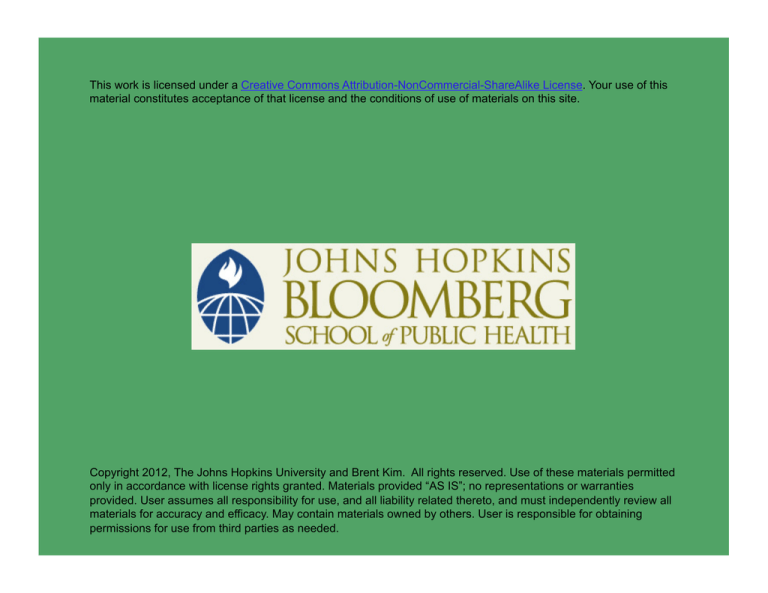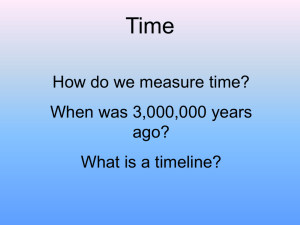
This work is licensed under a Creative Commons Attribution-NonCommercial-ShareAlike License. Your use of this
material constitutes acceptance of that license and the conditions of use of materials on this site.
Copyright 2012, The Johns Hopkins University and Brent Kim. All rights reserved. Use of these materials permitted
only in accordance with license rights granted. Materials provided “AS IS”; no representations or warranties
provided. User assumes all responsibility for use, and all liability related thereto, and must independently review all
materials for accuracy and efficacy. May contain materials owned by others. User is responsible for obtaining
permissions for use from third parties as needed.
Section B
Early History
Copyright © 2012 Johns Hopkins University and Brent Kim. Creative Commons Attribution-NonCommercial-ShareAlike License 3.0.
Early Humans
Origins: 150,000 years ago
Hunter gatherers
Left: Lost crops of Africa. Gingerbread plum (Mobola). National Academies Press. Center: Bill
Tarpenning, USDA. Right: Public Library of Science. Woolly mammoth in a late Pleistocene landscape
in Northern Spain. 2008. Creative Commons.
3
Transition to Agriculture
11,000 BCE: Early evidence
of agriculture
6000 BCE: Most farm
animals domesticated
5000 BCE: Agriculture
practiced in every continent
except Australia
Simmon, R. (2003). NASA Earth Observatory. Retrieved from
www.earthobservatory.nasa.gov/Features/HarranPlains/
4
Effects of Agriculture
More labor intensive, in some cases
10 to 100 more calories per acre
Grave chamber of Panehsi, scene with farmers and ass. Circa 1298– 1235 BCE.
Available at Wikimedia Commons.
5
Population Growth
10 000 BCE: ~4 million
1000 BCE: ~50 million
1 CE: ~200 million
Data source: McEvedy, Colin, and Jones, Richard. (1978). Atlas of world population history
(pp. 342–351). New York: Facts On File, Inc. Retrieved from
http://www.census.gov/population/international/data/worldpop/table_history.php
6
Growth of Civilizations
Early cities: Uruk, 3000 BCE;
population 50,000
Arts
Literature
Technology
Politics
Social classes
Photo: Uruk temple façade. Available at: http://commons.wikimedia.org/wiki/File:Pergamonmuseum_-_Vorderasiatisches_Museum_007.JPG
7
Drivers of Famine
Population growth
Resource degradation
Changing climate
Drought
Conflict
Photo by Litchfield District Council. CC BY-NC-ND.
8
Soil Fertility
Photo by Chesapeake Bay Program.
CC BY-NC.
Photo by Simon Q. CC BY-NC-ND.
Photo by kt.ries. CC BY-NC.
9
The Plow
“… the plow has been
more destructive than
the sword”
Funerary stele from the Louvre
Museum features plowman, cattle.
Circa 100–300 CE, Southern Arabia.
Available at Wikimedia Commons.
10
Soil Erosion
Dust Bowl, 1930s
Midwestern United States
USDA. Buried machinery in barn lot in Dallas, South Dakota, United
States during the Dust Bowl. (1936). Public domain.
11
Population Growth
10 000 BCE: ~4 million
1000 BCE: ~50 million
1 CE: ~200 million
Data source: McEvedy, Colin, and Jones, Richard. (1978). Atlas of world population history
(pp. 342–351). New York: Facts On File, Inc. Retrieved from
http://www.census.gov/population/international/data/worldpop/table_history.php
12
Europe
Periodic famine
Wolgemut, M. (1493). Dance of death. Public domain.
13
Thomas Malthus
Assumptions, 1798
- Exponential population
growth
-
Linear increases in food
production
Warned of widespread famine
Linnell J. (1822). Portrait of Thomas Malthus. Public Domain.
14
Population Growth
1650 CE: 550 million
1850 CE: 1.2 billion
1900 CE: 1.65 billion
Data source: McEvedy, Colin, and Jones, Richard. (1978). Atlas of world population history
(pp. 342–351). New York: Facts On File, Inc. Retrieved from
http://www.census.gov/population/international/data/worldpop/table_history.php
15
Synthetic Nitrogen Fertilizers
1900s
Credited for fueling
population growth
from 1.6 to 6 billion
Ammonia, used in synthetic nitrogen fertilizers, is
manufactured in plants like this one.
Photo by Carlee Ross. CC BY-NC.
16
Review
17






